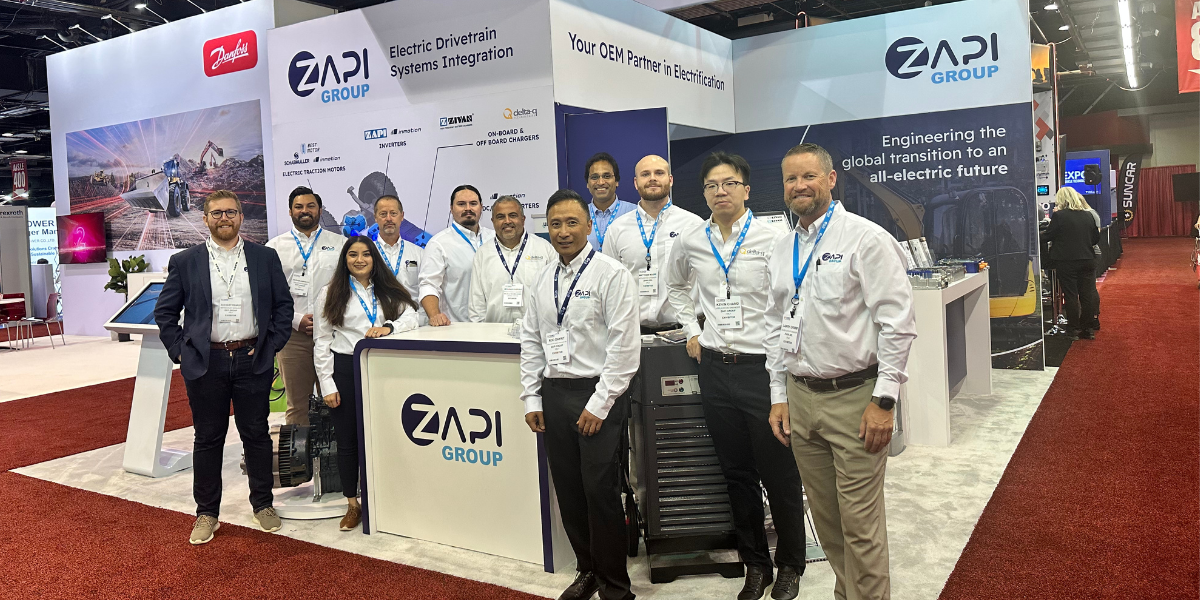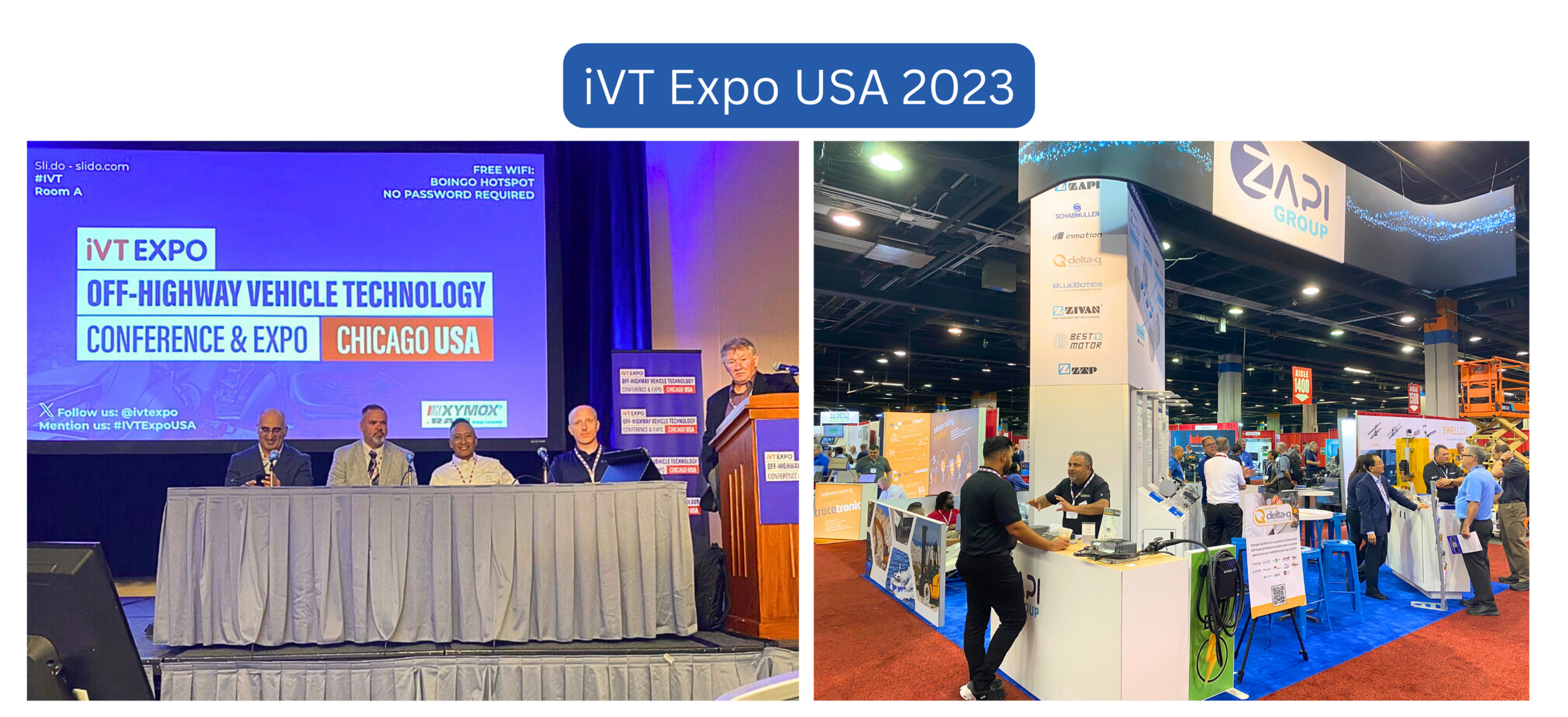This year marked the 4th edition of the iVT Expo and Conference in North America, and for the first time, it was co-located with the Electric & Hybrid Marine Conference. This strategic combination brought together innovative leaders from both land and sea.
Delta-Q Technologies was proud to co-exhibit with other member companies of the ZAPI GROUP team at this dynamic event, each showcasing battery charging, motive power and telematics solutions for electric vehicles (EVs). We also co-presented with Inventus Power, as part of the conference agenda, about best practices in battery and charger integration for off-highway vehicle electrification.
Based on our interactions from the show floor and in conference sessions the ZAPI GROUP made note of five critical emerging trends that are reshaping the electrification landscape.
Here’s what industry leaders need to know:
Trend #1: The Great Motivation Shift – From Compliance to Competitive Advantage
The industry has fundamentally shifted from regulatory-driven electrification to performance-focused transformation. Original Equipment Manufacturers (OEMs) are no longer solely motivated to electrify due to regulatory pressures. With some regulatory rollbacks stemming from shifting geopolitical developments, OEMs are discovering that electric systems unlock capabilities that traditional engines cannot match. These primary factors include:
- Vehicle performance
- Efficiency
- Cost savings
- Automation and autonomy
OEMs that are still viewing electrification as a regulatory checkbox are missing the strategic opportunity. The real market leaders are using electric systems as a competitive advantage to deliver innovative, efficient solutions, to the benefit of their end-users.
Trend #2: The Rise of All-in-One Systems
Instead of improving each component separately, the off-highway EV industry is now combining core systems (e.g., charging, power management, motor control, and energy export) into unified, integrated systems. This approach is proving to be more reliable, efficient, and cost-effective than piecing together separate parts.
This shift is a fundamental move toward system-level thinking, where success depends on platform integration rather than individual solutions. Examples include:
- Integrated charger combinations that handle multiple power conversion needs
- eAxle systems that unify motor, inverter, and transmission functions
- Export power capabilities enabling vehicle-to-grid, vehicle-to-vehicle and vehicle-to-load applications
Trend #3: Advancing Marine Electrification Charts Sustainable Growth
Marine electrification (specifically through the application of advanced battery technologies), is growing fast. But adoption patterns show a clear divide based on how often vessels are deployed.
Commercial marine electrification is progressing most rapidly across:
- Cargo and cruise ships
- Commercial vessels
- Working boats (tugboats, pilot boats, patrol vessels)
These commercial segments are predominantly high voltage, and the investment justification of these machines is based on fuel savings and predictable routines. Moreover, many ports around the globe are mandating vessels to use shoreside electricity when docked. Onshore electrical power peak demand in terminals is expected to triple by 2040, underscoring the need for scalable charging solutions.
Meanwhile, the main obstacle for recreational crafts electrification is low usage. On average, these vessels are utilized for 35-48 hours per year compared to 1000s of hours for commercial crafts! This makes the business case for electrification very challenging.
Overall, the lesson is clear: marine electrification success requires understanding real-world usage rather than applying one-size-fits-all solutions.
Trend #4: Hydraulics’ Smart Evolution
Rather than disappearing, hydraulic systems are evolving to work alongside electric systems in hybrid setups. For high-power, hydraulics often remain the most cost-effective solution, and they are continuing to evolve by improving power efficiency and energy recovery. The main advantage is the valving system that can cost-effectively distribute power to numerous hydraulic actuators.
In contrast, a fully electric mid-size construction vehicle would require the use of a dozen or more motors and associated controllers, which makes it expensive. Hence, the future lies in smart integration where electric and hydraulic systems are designed to work together, leveraging each technology’s strengths rather than forcing everything to be electric.
Trend #5: Cybersecurity Becomes Essential
Connected electric vehicles are accelerating the need for cybersecurity solutions, as protection moves from a future concern to an immediate necessity. With vehicles increasingly functioning as rolling computers, equipped with internet connectivity and autonomous features, they are becoming vulnerable to cyberattacks.
Security is no longer a nice-to-have, but a must-have. OEMs that do not integrate cybersecurity into their electrification strategy risk losing trust with security-conscious customers.
Key trends shaping this shift include:
- New standards establishing baseline security requirements
- Hardware-based security offering robust, tamper-resistant protection
- Communication filtering technologies safeguarding vehicle data exchanges
The Bottom Line
These five trends point to a common theme: electrification is becoming strategic, not just technical. Vehicle manufacturers thriving in this transition are those that understand electrification as a platform for competitive advantage, not just a technology upgrade.
The window for defining market position is narrowing rapidly. The question for industry leaders is not whether to take part in this transformation, but how quickly they can adapt their strategies to capitalize on these emerging realities.





